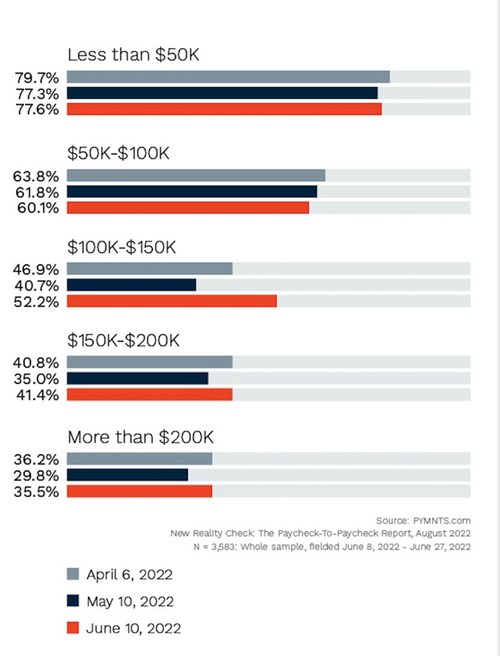Number of Consumers Living Paycheck to Paycheck Has Increased Year-Over-Year Across All Income Levels
- 61% or 203 Million Americans are Living Paycheck To Paycheck, Up from 55% a Year Ago
- 33.5 million Americans spent more than they earned in the past six months
The economic reality under the Biden administration’s policies is forcing an increasing number of Americans to burn through savings and live paycheck-to-paycheck.
A new report released today examines the financial lifestyle of U.S. consumers who live paycheck to paycheck, the factors that cause financial distress and the impact of financial stressors on their ability to manage expenses and put aside savings.
Key Findings from Reality Check: Paycheck-To-Paycheck research series:

- In June 2022, 61% of Americans were living paycheck to paycheck, up from a low of 52% in April 2021 and 55% in June 2021.
- Average savings dropped $517 from $11,724 in May 2022 to $10,757 in June 2022.
- The biggest rise in paycheck-to-paycheck consumers was in consumers earning between $100,000 and $150,000, up 11 percentage points from May 2022 to 52% in June 2022.
- The average consumer stores 11% of their savings in either stocks or bonds, yet half of all stockholders reported that their portfolios recently lost value in the last three months.
- An estimated 33.5 million — or 13% — of U.S. consumers spent more than they earned in the past six months.
“What a difference a year makes. Last summer we were all worried about how quickly the economy would recover. Now, as inflation continues its upwards swing, consumers are finding it more difficult to manage spending and are eating into their savings as financial pressures mount,” said Anuj Nayar, LendingClub’s Financial Health Officer. “That said, consumers are not yet slowing down their spending habits, despite the rise in the cost of living. Not only is it going to be difficult for them to handle future emergency expenses, but even foreseen payments like education, student loans, or housing expenses may be harder to balance for the everyday American consumer.”
Today’s Paycheck-To-Paycheck Landscape
Living paycheck to paycheck is the most common financial lifestyle in the United States, with increasing numbers of high-income consumers now living paycheck to paycheck. In June 2022, 61% of Americans were living paycheck to paycheck, up from a low of 52% in April 2021 and 55% in June 2021.
The highest income brackets have experienced significant upswings in the share living paycheck to paycheck from May to June 2022. The biggest rise in paycheck-to-paycheck consumers was for those earning between $100,000 and $150,000, up 11 percentage points since May 2022 to 52%. Forty-one percent of those earning between $150,000 and $200,000 annually lived paycheck to paycheck in June 2022, up six percentage points from 35% in May. Furthermore, the share of consumers earning more than $200,000 who lived paycheck to paycheck rose 6 percentage points from 30% in May to 36% in June 2022.
Figure: Consumers living paycheck to paycheck in last three months
Share of consumers who live paycheck to paycheck, over time and by annual income
How Inflationary Pressures Impact Savings
An estimated 33.5 million — or 13% — of U.S. consumers spent more than they earned in the past six months. Among all U.S. consumers, average savings dropped from $11,274 in May to $10,757 in June, an indication that inflation has had an impact on all consumers’ ability to save.
Paycheck-to-paycheck consumers are more likely to prioritize easy access to funds when choosing where to hold their savings, keeping an average of 70% of their money in banks, digital wallets, or cash. Preference for more diversified portfolios increases significantly among high-income consumers.
When choosing how to save, the average consumer has half of their available savings stored in a bank or digital wallet such as PayPal or Venmo. The average consumer also keeps 11% of their savings in either stocks or bonds, and 20% in education or retirement accounts. Meanwhile, consumers in the highest income bracket allocate an average of 58% of their savings to assets other than cash or funds in a financial institution. Consumers earning more than $200,000 per year invested 28% of their available savings in stocks and bonds, while consumers earning between $100,000 and $200,000 invested 14% of their available savings in stocks and bonds.
The most cited factor influencing how consumers store their savings is ease of access to their money, cited by 46% of consumers who have savings. While quick access is the dominant factor influencing savings preferences among paycheck-to-paycheck consumers and lower income consumers, the preference for diversified portfolios increases significantly among high-income consumers: 31% of consumers earning more than $200,000 annually said having a diversified portfolio is the most important reason for choosing how they store their savings, compared to just 8.7% of those earning less than $50,000 per year.
Recent stock market volatility and inflation have made ease of access to funds more of a priority for financially struggling consumers than for those with higher incomes who may be more able to have a longer-term horizon on their savings portfolios.
Content created by Conservative Daily News and some content syndicated through CDN is available for re-publication without charge under the Creative Commons license. Visit our syndication page for details and requirements.




